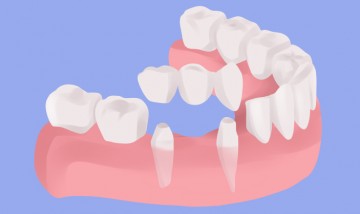If you have a gap left by a missing tooth this can put more strain on the teeth at either side and affect your ‘bite’ as the teeth next to the space can lean into the gap and change the way the upper and lower teeth bite together. This can then lead to food getting stuck in the gap, causing decay and gum disease.
Bridges or partial dentures may be the answer.
Bridges are exactly that: a bridge. Most bridges are fixed prosthetic devices that cover the gap between existing natural teeth or implants. The adjacent teeth are prepared as crowns and hold a false tooth in place.
A partial denture is a plate with one or more false teeth on it. They are made of plastic or a mixture of metal and plastic. Both types may have clips (clasps) to help keep the denture in place in your mouth. Depending on where they are, some of these clips may show when you smile or open your mouth.
The dentist will advise on the best option for your teeth and explain the ins and outs of each option to allow you to decide if this is the route you want to go. If you have more questions, we have answers below. If you’re still concerned, then contact us today!
This depends on the number of teeth missing, where they are in your mouth, and the condition of your remaining teeth.
There are three main ways to replace missing teeth.
1. Removable false tooth (or teeth) – called a partial denture.
2. Fixed bridge. Usually used when there are fewer teeth to replace, or when the missing teeth are only on one side of the mouth.
3. Dental implants. This is where an artificial root is placed into the bone of the jaw and a crown or bridge placed on top of this.
Plastic partial dentures are less expensive but,unless they are designed very carefully, can damage the teeth they fit against.
Metal partial dentures are usually made from an alloy of cobalt and chromium and are much stronger. They are lighter to wear and can be supported by the remaining teeth. Although the base is metal, they have gum-coloured plastic and natural-looking teeth fixed to them. They are more expensive than plastic ones.
It is best to allow up to six months for your gums to heal properly after an extraction. A temporary denture can be put in the gap meanwhile, before the bridge is fitted.
You can have a bridge only if you have enough strong teeth with good bone support or dental implants that can hold the bridge in place. The dentist can advise on the best options for your mouth.
You should care for your dental bridge by cleaning it every day. This will help to prevent problems such as bad breath and gum disease. You should also clean under the false tooth every day. We will show you how to use a bridge needle or special floss to reach this tricky to get to areas.
One of the benefits of dental implants is that you may be able to replace missing teeth without having to have crowns on other teeth. Talk to the dentist about the options and the pros and cons of each.




